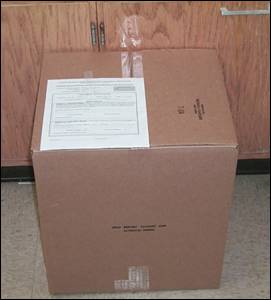Biologicals
Purdue Biological Safety Manual: the section dealing with WHAT EXACTLY are biohazards is Appendix D: Biological Agent Risk Classification. It's long, and quoted pretty directly from NIH. It is required. The sections dealing with BIO-WASTE TREATMENT AND PICK-UP are on the page numbered 24 and in Appendix B.
- List of Select Agents from CDC: Agents having potential for use in bioterrorism. Individuals (grad students, postdocs, faculty members) can now go to prison for incorrect management of select agents.
- Department of Health and Human Services Final Rule: (Federal Register final rule affects 42 CFR Parts 72, 73 and 1003, possession, use, and transfer of select agents and toxins)
- Department of Agriculture Final Rule: (Federal Register final rule affects 7 CFR Part 331 and 9 CFR Part 121, regarding animal and plant health inspections)
Shipping hazardous materials:
See the REM information about shipping. "Hazardous materials" might include things that are not incredibly hazardous but require careful shipping details to be attended to. SHIPPING of biological samples is highly regulated, and even the most benign-seeming small thing which 20 years ago you would have just popped into an envelope and sent to your colleague at Cambridge must be considered carefuly by the people who know how to follow all of the the Deparetment of Transportation rules.
Blood or other body fluid or waste clean-up:
REM provides a page of guidance. If you discover a biological mess of some kind (vomit, blood, etc) in BRWN or WTHR or other academic building (this does not apply to residence halls), notify the building deputy (for BRWN and WTHR call the building deputy Ned Gangwer or someone on his staff in the Chem Shop 45209 or 45211). If you cannot reach the building deputy or he/she cannot respond, or during other hours phone the Purdue Police business line and they will contact the Building Services supervisor and have trained people come to clean it up.
IF POSSIBLE the person whose blood or other body fluid is to be cleaned up should be the person to clean it up, since that person is not at risk from their own body fluids. If practical, cordon off the area until the person responsible for the body fluid(s) can return and mop it up.
- Bio waste disposal
- Biosafety Cabinet Installation/Moving/Certification
BBP training:
Required of those working with unfixed human tissue or primary cell lines, human blood or blood products. Commercially obtained cell lines do not trigger the training requirement (at the discretion of the Biosafety Officer). But these will trigger the training requirement if they are obtained from another lab, due to the potential of disease contamination. Note: commercially obtained cell lines used in research must be registered with the PU Institutional Biosafety Committee where we require the PI to review BSL2 lab practices.
Institutional Biosafety Committee: VP Research Office, licensing requirements for any and all research or teaching work with any and all biohazards. IBC Forms 1A, 2A, and Bio-lab cleanout/closure documentation form are at this OVPR page.
From CDC and NIH:
Biosafety in Microbiological and Biomedical Laboratories (BMBL) 4th Edition
Answers to detailed questions, for example "exactly what kind of work with Yersinia pestis requires BSL3 containment?"
